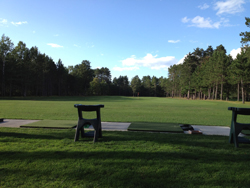Slow play has become a large problem for the game of golf. Unfortunately it is not uncommon for an 18 hole round of golf to take over five hours. I’m not a speed golfer but I can play a round in three hours with no traffic on the course. The golf industry would love for golfers to be able to complete rounds in four hours. Slow play is not directly related to being a high handicap golfer. It’s not the number of strokes that one takes but instead all of the activity in between. Look at the professional golf tours. These golfers have their livelihoods on the line with every shot so they have a reason to take their time. Still, pace of play on the professional tours is agonizingly slow. So while you can glean some tips from watching pros on TV, don’t mimic their slow play.
So what causes slow play and what can golfers do to speed up the pace?
A big reason for slow play is not having a consistent, timely pre-shot routine for all of your shots, including full swings, pitches, chips and putts. Having a timely routine involves selecting the right club. This requires judging the distance, wind, lie of the ball and elevation change to the hole. Once you have the right club, take one practice swing,line up to a target and take your shot. One practice swing is plenty. The time for practice swings is on the driving range.
Putting is arguably the most important part of your golf game. More strokes are taken with your putter than any other club. This makes reading putts very important to your success. However, many golfers take way too long to complete their pre-putt routines. I believe reading putts requires getting a side view to judge elevation and a view from below the hole. I view from above the hole is also beneficial but only when time allows. But like the full swing pre-shot routine, many times some of the reads can be completed before your turn while others are reading their putts. While walking up to the green, get a look at the general slope of the green. Then, if others are playing before you, get a read or two on your putt while they are reading theirs. Be sure to be out of the way and quiet as they line up over their ball and putt.
Ironically, another source of slow play is the riding cart. Many times golfers in the same cart will ride over to one of the player’s ball on one side of the fairway and the other person will wait there the whole duration of the pre-shot routine and shot. They will then drive over to the other player’s ball and do the same. This is too time consuming and the wrong way to play cart golf. For times when two players in a cart are on opposite sides of the fairway, the driver should drive the passenger to their ball. The passenger should quickly determine their club to use. If they are in between clubs, the passenger should take both and the driver should go to their ball. This way both players can prepare and take their shots without a lot of unnecessary waiting.
Searching for lost golf balls is also a source of slow play. By rule you are allowed five minutes to search for a lost ball. During casual play, the only time you should take five minutes is when your ball is lost in an area where you have a next shot if you find it. For example, many times your ball can get lost in the rough. If you hit your ball in the thick woods, by all means take a minute to look for it (after all they’re expensive), but then take a drop since you wouldn’t have a realistic next shot even if you found it. One more thing about searching for lost balls. Other members in the group should hit their next shots before helping the player search for their lost ball. Do not have your entire foursome looking for a lost ball before they have taken their next shots.
Keep an eye on your pace of play next time you are on the course. If the course is busy and the hole in front of you is completely open, you’re probably playing too slow. Make sure you are using the ideas we discussed and speed up your play.





